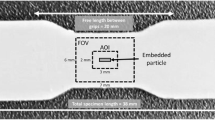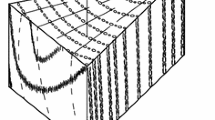Summary
Typical fracture characteristic values like load-displacement curve and specific fracture energy of the new wood laminate compound PARALLAM® PSL were determined by using the wedge splitting technique. Comparison with the values of solid wood and particleboard showed the superiority of this wood composite in both “weak” transverse orientations. This result is explained by the favourably oriented wood strands in PARALLAM® PSL with a length up to 2.6 m, which give rise to crack arresting mechanisms. In addition the influence of specimen geometry on the critical load and corresponding loadpoint-displacement at crack initiation was calculated for both isotropic and orthotropic materials using linear elastic FE-models.
Similar content being viewed by others

References
Aicher S, Reinhardt HW (1993) Einfluß der Bauteilgröße in der linearen und nichtlinearen (Holz-Bruchmechanik. Holz Roh- Werkstoff 51: 215–220
Bazant ZP (1984) Size effect in blunt fracture: Concrete, rock, metal. J. of Engineering Mechanics 110(4): 518–535
Ehart RJA (1994) Charakterisierung des Bruchverhaltens von Holzfaser-Verbundwerkstoffen. Experimente, Modellierung und FE-Simulationen. Master Thesis, Technical University of Vienna
Ehart RJA, Stanzl-Tschegg SE, Tschegg EK (1996a) Fracture mechanisms in particleboard — experiments and FE-simulations. Proceedings of the 2nd International Conference of Wood Science, Technology and Forestry (ICWSF 96), Sopron 1996
Ehart RJA, Stanzl-Tschegg SE, Tschegg EK (1996b): Fracture behaviour of particleboard-Influence of the specimen goemetry. Proceeding of COST 508 Wood Mechanics, Stuttgart 1996
Nakayama J (1965) Direct measurement of fracture energies of brittle heterogeneous materials. J. Am. Ceram. Soc. 48(11): 583–587
Sakai M, Ichikawa H (1992) Work-of-fracture of brittle materials with microcracking and crack bridging. Int. J. of Fracture 55: 65–79. Kluwer Academic Publishers, Netherlands
Stanzl-Tschegg SE, Tan DM, Tschegg EK (1995) New splitting method for wood fracture characterization. Wood Science and Technology 29: 31–50
Stanzl-Tschegg SE, Ehart RJA, Tschegg EK (1997) Fracture behaviour of glued wood laminate compounds. 9th Internat. Conf. on Fracture (ICF9), Sydney, Australia
Tschegg EK (1986) Equipment and appropriate specimen shapes for tests to measure fracture values (in German). Patent No. 390328, 1986, Österreichisches Patentamt
Tschegg EK (1991) New equipments for fracture tests on concrete. Materials Testing: 338–342
Tschegg EK, Stanzl-Tschegg SE (1997) Fracture mechanical characterization of asphalt aggregate mixtures. 9th Internat. Conf. on Fracture (ICF9), Sydney, Australia
Author information
Authors and Affiliations
Additional information
The authors thank Trus Joist McMillan for supplying the testing material and especially Dir. Donald Sharp for his helpful cooperation. Financial support by the Austrian National Bank (project no. 4917) is gratefully acknowledged.
Rights and permissions
About this article
Cite this article
Ehart, R.J.A., Stanzl-Tschegg, S.E. & Tschegg, E.K. Fracture characteristics of PARALLAM® PSL in comparison to solid wood and particleboard. Wood Sci.Technol. 32, 43–55 (1998). https://doi.org/10.1007/BF00702559
Received:
Issue Date:
DOI: https://doi.org/10.1007/BF00702559



